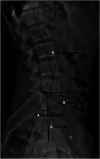Evaluation of additional causes of hip pain in patients with femoroacetabular impingement syndrome
- PMID: 36034352
- PMCID: PMC9399470
- DOI: 10.3389/fsurg.2022.697488
Evaluation of additional causes of hip pain in patients with femoroacetabular impingement syndrome
Abstract
Femoroacetabular impingement syndrome (FAIS) is an increasingly prevalent pathology in young and active patients, that has contributing factors from both abnormal hip morphology as well as abnormal hip motion. Disease progression can be detrimental to patient quality of life in the short term, from limitations on sport and activity, as well as the long term through early onset of hip arthritis. However, several concurrent or contributing pathologies may exist that exacerbate hip pain and are not addressed by arthroscopic intervention of cam and pincer morphologies. Lumbopelvic stiffness, for instance, places increased stress on the hip to achieve necessary flexion. Pathology at the pubic symphysis and sacroiliac joint may exist concurrently to FAIS through aberrant muscle forces. Additionally, both femoral and acetabular retro- or anteversion may contribute to impingement not associated with traditional cam/pincer lesions. Finally, microinstability of the hip from either osseous or capsuloligamentous pathology is increasingly being recognized as a source of hip pain. The present review investigates the pathophysiology and evaluation of alternate causes of hip pain in FAIS that must be evaluated to optimize patient outcomes.
Keywords: FAI (Femoroacetabular impingemet); lumbosacral pain; osteitis pubis; pseudoradicular pain; sacroiliac pain.
© 2022 Gowd, Beck, Trammell, Edge and Stubbs.
Conflict of interest statement
The authors declare that the research was conducted in the absence of any commercial or financial relationships that could be construed as a potential conflict of interest.
Figures




References
-
- DeAngelis NA, Busconi BD. Assessment and differential diagnosis of the painful hip. Clin Orthop Relat Res. (2003) 406:11–8. 10.1097/01.blo.0000043039.84315.be - DOI - PubMed
-
- Reiman MP, Agricola R, Kemp JL, Heerey JJ, Weir A, van Klij P, et al. Consensus recommendations on the classification, definition and diagnostic criteria of hip-related pain in young and middle-aged active adults from the International Hip-related Pain Research Network, Zurich 2018. Br J Sports Med. (2020) 54:631–41. 10.1136/bjsports-2019-101453 - DOI - PubMed
Publication types
LinkOut - more resources
Full Text Sources

